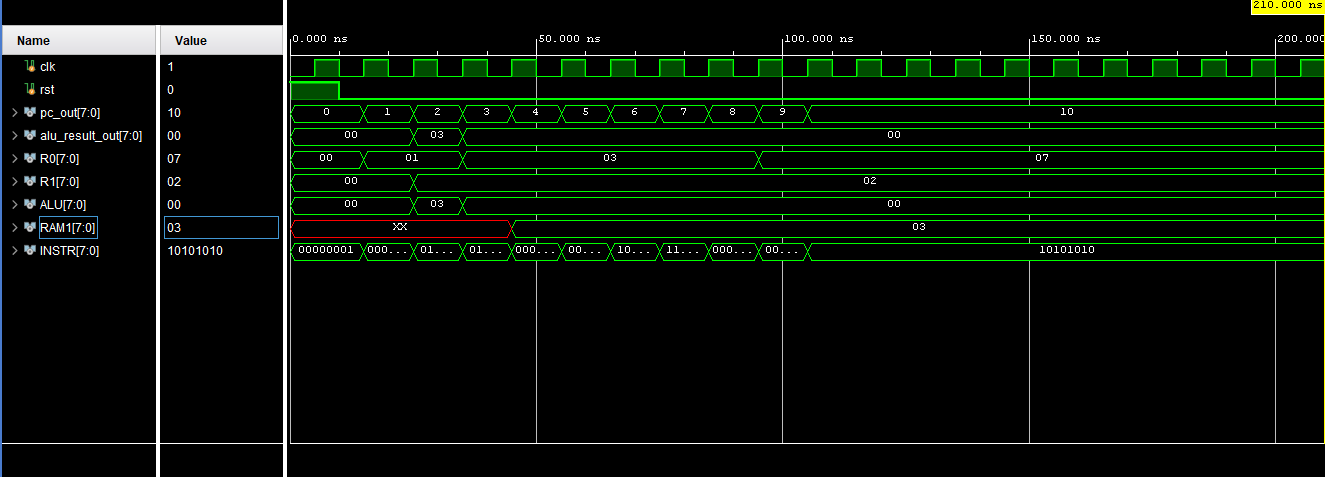6-Instruction CPU
一、CPU 結構圖

註:CPU 結構採單週期架構,所有模組皆於一個時脈週期內完成。
二、指令集說明
| Opcode | 指令名稱 | 格式 | 功能說明 |
|---|---|---|---|
| 000 | LOADI | LOADI Rx, Imm | 將立即數寫入暫存器 Rx |
| 001 | LOAD | LOAD Rx, [Addr] | 從記憶體讀取資料至 Rx |
| 010 | STORE | STORE Rx, [Addr] | 將 Rx 的資料寫入記憶體 |
| 011 | ADD | ADD Rx, Ry | Rx = Rx + Ry |
| 100 | SUB | SUB Rx, Ry | Rx = Rx - Ry |
| 101 | JMP | JMP Addr | 跳躍至位址 Addr |
| 110 | JZ | JZ Addr | 若 Zero flag = 1 則跳至 Addr |
Rx, Ry 為暫存器 R0–R3,Addr 與 Imm 為 5 位元。
三、模組設計說明
1. 頂層模組(cpu)
負責整合各個模組,控制資料流與時脈推進。
module cpu (
input clk,
input rst,
output [7:0] pc_out,
output [7:0] alu_result_out
);
// 暫存線路
wire [7:0] pc;
wire [7:0] instr;
wire [2:0] opcode;
wire [4:0] operand;
wire [7:0] alu_out;
wire [7:0] reg_out1, reg_out2;
wire [1:0] reg_sel1, reg_sel2;
wire [7:0] ram_out;
wire mem_write;
wire zero_flag;
wire reg_we;
wire [7:0] write_data;
assign pc_out = pc;
assign alu_result_out = alu_out;
assign write_data = (opcode == 3'b000) ? {5'b00000, operand[2:0]} : alu_out;
// 模組實例化
pc pc_unit(
.clk(clk),
.rst(rst),
.jump_addr({3'b000, operand}),
.jump_en((opcode == 3'b101) || ((opcode == 3'b110) && zero_flag)),
.pc(pc)
);
rom rom_unit(.addr(pc), .data(instr));
controller controller_unit(
.instr(instr),
.opcode(opcode),
.operand(operand),
.reg_sel1(reg_sel1),
.reg_sel2(reg_sel2),
.mem_write(mem_write),
.reg_we(reg_we)
);
regfile regfile_unit(
.clk(clk),
.rst(rst),
.we(reg_we),
.ra(reg_sel1),
.rb(reg_sel2),
.wd(write_data),
.a_data(reg_out1),
.b_data(reg_out2)
);
alu alu_unit(.a(reg_out1), .b(reg_out2), .op(opcode), .y(alu_out), .zero(zero_flag));
ram ram_unit(.clk(clk), .addr(operand[3:0]), .we(mem_write), .din(reg_out1), .dout(ram_out));
endmodule
2. PC(程式計數器)
維護目前指令位址,支援條件跳躍。
module pc (
input clk,
input rst,
input [7:0] jump_addr,
input jump_en,
output reg [7:0] pc
);
always @(posedge clk or posedge rst) begin
if (rst) pc <= 0;
else if (jump_en) pc <= jump_addr;
else pc <= pc + 1;
end
endmodule
3. ROM
初始化指令集,僅讀取不寫入。
module rom (
input [7:0] addr,
output reg [7:0] data
);
reg [7:0] memory [0:255];
integer i;
initial begin
for (i = 0; i < 256; i = i + 1)
memory[i] = 8'b000_00_000; // 預設 NOP
memory[0] = 8'b000_00_001; // LOADI R0, 1
memory[1] = 8'b000_01_010; // LOADI R1, 2
memory[2] = 8'b011_00_010; // ADD R0 += R1
memory[3] = 8'b010_00_001; // STORE R0 → RAM[1]
memory[4] = 8'b000_10_011; // LOADI R2, 3
memory[5] = 8'b000_11_011; // LOADI R3, 3
memory[6] = 8'b100_10_110; // SUB R2 -= R3
memory[7] = 8'b110_01000; // JZ to 8
memory[8] = 8'b000_00_111; // LOADI R0, 7 (should be skipped)
memory[9] = 8'b001_11_001; // LOAD R3 ← RAM[1]
memory[10]= 8'b101_01010; // JMP loop HALT (to address 10)
end
always @(*) begin
data = memory[addr];
end
endmodule
4. RAM
資料記憶體,可寫入或讀取。
module ram (
input clk,
input [3:0] addr,
input we,
input [7:0] din,
output reg [7:0] dout
);
reg [7:0] mem [0:15];
always @(posedge clk) begin
if (we)
mem[addr] <= din;
dout <= mem[addr];
end
endmodule
5. Controller
解析指令並輸出控制訊號(opcode、reg_we、mem_write、jump_en)。
module controller (
input [7:0] instr,
output [2:0] opcode,
output [4:0] operand,
output [1:0] reg_sel1,
output [1:0] reg_sel2,
output mem_write,
output reg_we,
output jump_en_conditional
);
assign opcode = instr[7:5];
assign operand = instr[4:0];
assign reg_sel1 = instr[4:3];
assign reg_sel2 = instr[2:1];
assign mem_write = (opcode == 3'b010); // STORE
assign reg_we =
(opcode == 3'b000) || // LOADI
(opcode == 3'b001) || // LOAD
(opcode == 3'b011) || // ADD
(opcode == 3'b100); // SUB
assign jump_en_conditional = (opcode == 3'b110); // JZ
endmodule
6. RegFile
四組暫存器(R0–R3),支援雙讀單寫。
module regfile (
input clk,
input rst,
input we,
input [1:0] ra,
input [1:0] rb,
input [7:0] wd,
output [7:0] a_data,
output [7:0] b_data
);
reg [7:0] regs [0:3];
assign a_data = regs[ra];
assign b_data = regs[rb];
always @(posedge clk or posedge rst) begin
if (rst) begin
regs[0] <= 0;
regs[1] <= 0;
regs[2] <= 0;
regs[3] <= 0;
end else if (we) begin
regs[ra] <= wd;
end
end
endmodule
7. ALU
支援加法、減法運算,輸出 zero flag。
module alu (
input [7:0] a,
input [7:0] b,
input [2:0] op,
output reg [7:0] y,
output zero
);
always @(*) begin
case (op)
3'b011: y = a + b; // ADD
3'b100: y = a - b; // SUB
default: y = 8'd0;
endcase
end
assign zero = (y == 0);
endmodule
四、模擬與測試
測資指令(ROM 中)
memory[0] = 8’b000_00_001; // LOADI R0, 1
memory[1] = 8’b000_01_010; // LOADI R1, 2
memory[2] = 8’b011_00_010; // ADD R0 += R1
memory[3] = 8’b010_00_001; // STORE R0 → RAM[1]
memory[4] = 8’b000_10_011; // LOADI R2, 3
memory[5] = 8’b000_11_011; // LOADI R3, 3
memory[6] = 8’b100_10_110; // SUB R2 -= R3
memory[7] = 8’b110_01000; // JZ to 8
memory[8] = 8’b000_00_111; // LOADI R0, 7 (should be skipped)
memory[9] = 8’b001_11_001; // LOAD R3 ← RAM[1]
memory[10]= 8’b101_01010; // JMP loop HALT (to address 10)
模擬結果波形圖

測試重點
- LOADI 正確寫入 R0, R1
- ADD 成功相加
- STORE 寫入 RAM[1]
- SUB 結果為零時觸發 JZ
- LOAD 成功將 RAM[1] 讀至 R3
五、結論與心得
本次專題完成一顆自訂 6 指令 CPU,並以模組化方式建構。過程中理解 CPU 單週期架構的資料流與控制流,熟悉 Verilog 行為式設計與模擬技巧,成功驗證各種運算與跳躍邏輯。後續若擴充指令集或導入 pipeline,可參考本架構進行微調。